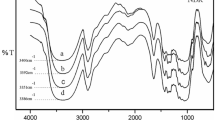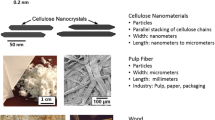Abstract
Mechanochemistry is a rapidly developing field in organic chemistry and materials processing. Its application to cellulose has not been abundant, but is giving rise to important discoveries after ca. 2010. Here the works on mechanochemical processing of cellulose and related substances are reviewed under classification of reaction types: saccharification, esterification, radical reactions, decrystallization/nano-dispersion. Historical development in each topic is tabulated. Special emphasis is laid on solid-state milling by ball mill/attritor. Notable recent findings are briefly commented. Potential of mechanical devices is discussed. 82 references.

Reproduced from Hick et al. (2010) with permission

Reproduced from Käldström et al. (2014) with permission

Reproduced from Dornath et al. (2015) with permission

Reproduced from Huang et al. (2012) with permission

Reproduced from Ago et al. (2007) with permission

Reproduced from Zhao et al. (2016b) with permission

Reproduced from Zhao et al. (2016a) with permission
Similar content being viewed by others
Notes
Another important cellulose ester is nitrate, but challenge for it is not endorsed for its intrinsic hazard.
References
Ago M, Endo T, Hirotsu T (2004) Crystalline transformation of native cellulose from cellulose I to cellulose ID polymorph by a ball-milling method with a specific amount of water. Cellulose 11:163–167
Ago M, Endo T, Okajima K (2007) Effect of solvent on morphological and structural change of cellulose under ball-milling. Polym J 39:435–441
Baláž P, Achimovičová M, Baláž M, Billik P, Cherkezova-Zheleva Z, Criado J, Delogu F, Dutková E, Gaffet E, Gotor F, Kumar R, Mitov I, Rojac T, Senna M, Streletskii A, Wieczorek-Ciurowa K (2013) Hallmarks of mechanochemistry: from nanoparticles to technology. Chem Soc Rev 42:7571–7637
Bhama Iyer P, Sreenivasan S, Chidambareswaran PK, Patil NB (1984) Crystallization of amorphous cellulose. Text Res J 54:732–735
Bhama Iyer P, Sreenivasan S, Chidambareswaran PK, Patil NB (1986) Recrystallization of cellulose. Text Res J 56:509–511
Breiby DW, Sølling TI, Bunk O, Nyberg RB, Norrman K, Nielsen MM (2005) Structural surprises in friction-deposited films of poly(tetrafluoroethylene). Macromolecules 38:2383–2390
Bruckmann A, Krebs A, Bolm C (2008) Organocatalytic reactions: effects of ball milling, microwave and ultrasound irradiation. Green Chem 10:1131–1141
Calka A, Radlinski AP (1991) Universal high performance ball-milling device and its application for mechanical alloying. Mater Sci Eng A 134:1350–1353
Caulfield DF, Steffes RA (1969) Water-induced recrystallization of cellulose. TAPPI 52:1361–1366
Dornath P, Cho HJ, Paulsen A, Dauenhauer P, Fan W (2015) Efficient mechano-catalytic depolymerization of crystalline cellulose by formation of branched glucan chains. Green Chem 17:769–775
Fokina EL, Budim NI, Kochnev VG, Chernik GG (2004) Planetary mills of periodic and continuous action. J Mater Sci 39:5217–5221
Friščić T (2012) Supramolecular concepts and new techniques in mechanochemistry: cocrystals, cages, rotaxanes, open metal–organic frameworks. Chem Soc Rev 41:3493–3510
Furcht PW, Silla H (1990) Comparison of simultaneous wet milling and enzymatic hydrolysis of cellulose in ball mill and attrition mill reactors. Biotechnol Bioeng 35:630–645
Gaffet E et al (1999) Some recent developments in mechanical activation and mechanosynthesis. J Mater Chem 9:305–314
Gan T, Zhang Y, Su Y, Hu H, Huang H, Huang Z, Chen D, Yang M, Wu J (2017) Esterification of bagasse cellulose with metal salts as efficient catalyst in mechanical activation-assisted solid phase reaction system. Cellulose 24:5371–5387
Hermans PH, Weidinger A (1946) On the recrystallization of amorphous cellulose. J Am Chem Soc 68:2547–2552
Hermans PH, Weidinger A (1949) Change in crystallinity upon heterogeneous acid hydrolysis of cellulose fibers. J Polym Sci 4:317–322
Hess K, Kiessig H, Gundermann J (1941) Röntgenographische und elektronenmikroskopische. Z Phys Chem 49B:64–82
Hick SM, Griebel C, Restrepo DT, Truitt JH, Buker EJ, Bylda C, Blair RG (2010) Mechanocatalysis for biomass-derived chemicals and fuels. Green Chem 12:468–474
Hilgert J, Meine N, Rinaldi R, Schüth F (2013) Mechanocatalytic depolymerization of cellulose combined with hydrogenolysis as a highly efficient pathway to sugar alcohols. Energy Environ Sci 6:92–96
Hon DN-S (1979) Formation and behavior of mechanoradicals in pulp cellulose. J Appl Polym Sci 23:1487–1499
Hon DN-S (1980) On the reactivity of cellulose free radicals in graft copolymerization reactions. J Polym Sci A-Polym Chem 18:1857–1869
Howsmon JA, Marchessault RH (1959) The ball-milling of cellulose fibers and recrystallization effects. J Appl Polym Sci 1:313–322
Hu H et al (2015) Green mechanical activation-assisted solid phase synthesis of cellulose esters using a co-reactant: effect of chain length of fatty acids on reaction efficiency and structure properties of products. RSC Adv 5:20656–20662
Huang P, Wu M, Kuga S, Wang D, Wu D, Huang Y (2012) One-step dispersion of cellulose nanofibers by mechanochemical esterification in an organic solvent. ChemSusChem 5:2319–2322
Huang P, Wu M, Kuga S, Wang D, Wu D, Huang Y (2015) Aqueous pretreatment for reactive ball milling of cellulose. Cellulose 20:2175–2178
James SL et al (2012) Mechanochemistry: opportunities for new and cleaner synthesis. Chem Soc Rev 41:413–447
Jones EO, Lee JM (1988) Kinetic analysis of bioconversion of cellulose in attrition bioreactor. Biotechnol Bioeng 31:35–40
Käldström M, Meine N, Farès C, Schüth F, Rinaldi R (2014) Deciphering ‘water-soluble lignocellulose’ obtained by mechanocatalysis: new insights into the chemical processes leading to deep depolymerization. Green Chem 16:3528–3538
Kaneniwa N, Ikekawa A (1972) Influence of ball-milling atmosphere on decrease of molecular weight of polyvinylpyrrolidone powders. Chem Pharm Bull 20:1536–1543
Kaufman Rechulski MD, Käldström M, Richter U, Schüth F, Rinaldi R (2015) Mechanocatalytic depolymerization of lignocellulose performed on hectogram and kilogram scales. Ind Eng Chem Res 54:4581–4592
Kaupp G (2005) Organic solid-state reactions with 100% Yield. In: Toda F (ed) Organic solid state reactions. Springer, Berlin, pp 95–183
Kaupp G (2006) Waste-free large-scale syntheses without auxiliaries for sustainable production omitting purifying workup. CrystEngComm 8:794–804
Kaupp G, Schmeyers J, Naimi-Jamal MR, Zoz H, Ren H (2002) Reactive milling with the Simoloyer®: environmentally benign quantitative reactions without solvents and wastes. Chem Eng Sci 57:763–765
Kelsey RG, Shafizadeh F (1980) Enhancement of cellulose accessibility and enzymatic hydrolysis by simultaneous wet milling. Biotechnol Bioeng 22:1025–1036
Kleine T, Buendia J, Bolm C (2013) Mechanochemical degradation of lignin and wood by solvent-free grinding in a reactive medium. Green Chem 15:160–166
Kuzuya M, Yamauchi Y, S-i Kondo (1999) Mechanolysis of glucose-based polysaccharides as studied by electron spin resonance. J Phys Chem B 103:8051–8059
Lu Q, Lin W, Tang L, Wang S, Chen X, Huang B (2015a) A mechanochemical approach to manufacturing bamboo cellulose nanocrystals. J Mater Sci 50:611–619
Lu Q-l, Li X-y, Tang L-r, Lu B-l, Huang B (2015b) One-pot tandem reactions for the preparation of esterified cellulose nanocrystals with 4-dimethylaminopyridine as a catalyst. RSC Adv 5:56198–56204
Mais U, Esteghlalian AR, Saddler JN, Mansfield SD (2002) Enhancing the enzymatic hydrolysis of cellulosic materials using simultaneous ball milling. Appl Biochem Biotechnol 98:815–832
May PA, Moore JS (2013) Polymer mechanochemistry: techniques to generate molecular force via elongational flows. Chem Soc Rev 42:7497–7506
Meine N, Rinaldi R, Schüth F (2012) Solvent-free catalytic depolymerization of cellulose to water-soluble oligosaccharides. ChemSusChem 5:1449–1454
Motokawa T, Makino M, Enomoto-Rogers Y, Kawaguchi T, Ohura T, Iwata T, Sakaguchi M (2015) Novel method of the surface modification of the microcrystalline cellulose powder with poly(isobutyl vinyl ether) using mechanochemical polymerization. Adv Powder Technol 26:1383–1390
Murata Y, Han A, Komatsu K (2003) Mechanochemical synthesis of a novel C60 dimer connected by a germanium bridge and a single bond. Tetrahedron Lett 44:8199–8201
Nakagawa YS et al (2011) Development of innovative technologies to decrease the environmental burdens associated with using chitin as a biomass resource: mechanochemical grinding and enzymatic degradation. Carbohydr Polym 83:1843–1849
Neilson MJ, Kelsey RG, Shafizadeh F (1982) Enhancement of enzymatic hydrolysis by simultaneous attrition of cellulosic substrates. Biotechnol Bioeng 24:293–304
Niu Y, Zhang X, He X, Zhao J, Zhang W, Lu C (2015) Effective dispersion and crosslinking in PVA/cellulose fiber biocomposites via solid-state mechanochemistry. Int J Biol Macromol 72:855–861
Ott RL (1964) Mechanism of the mechanical degradation of cellulose. J Polym Sci A: Gen Pap 2:973–982
Paes SS, Sun S, MacNaughtan W, Ibbett R, Ganster J, Foster TJ, Mitchell JR (2010) The glass transition and crystallization of ball milled cellulose. Cellulose 17:693–709
Qi X, Yang G, Jing M, Fu Q, Chiu F-C (2014) Microfibrillated cellulose-reinforced bio-based poly(propylene carbonate) with dual shape memory and self-healing properties. J Mater Chem A 2:20393–20401
Qiu W, Zhang F, Endo T, Hirotsu T (2004) Milling-induced esterification between cellulose and maleated polypropylene. J Appl Polym Sci 91:1703–1709
Rao X, Kuga S, Wu M, Huang Y (2015) Influence of solvent polarity on surface-fluorination of cellulose nanofiber by ball milling. Cellulose 22:2341–2348
Rodriguez B, Bruckmann A, Rantanen T, Bolm C (2007) Solvent-free carbon–carbon bond formations in ball mills. Adv Synth Catal 349:2213–2233
Ryu SK, Lee JM (1983) Bioconversion of waste cellulose by using an attrition bioreactor. Biotechnol Bioeng 25:53–65
Sakaguchi M et al (2010) Diblock copolymer of bacterial cellulose and poly(methyl methacrylate) initiated by chain-end-type radicals produced by mechanical scission of glycosidic linkages of bacterial cellulose. Biomacromolecules 11:3059–3066
Sakaguchi M, Ohura T, Iwata T, Enomoto-Rogers Y (2012) Nano cellulose particles covered with block copolymer of cellulose and methyl methacrylate produced by solid mechano chemical polymerization. Polym Degrad Stab 97:257–263
Schmidt R, Fuhrmann S, Wondraczek L, Stolle A (2016) Influence of reaction parameters on the depolymerization of H2SO4-impregnated cellulose in planetary ball mills. Powder Technol 288:123–131
Schüth F, Rinaldi R, Meine N, Käldström M, Hilgert J, Rechulski MDK (2014) Mechanocatalytic depolymerization of cellulose and raw biomass and downstream processing of the products. Catal Today 234:24–30
Senna M (2010) The promising aspects of processing nanomaterials under mechanical stressing for physicochemical viewpoints. Adva Powder Technol 21:586–591
Shrotri A, Lambert LK, Tanksale A, Beltramini J (2013) Mechanical depolymerisation of acidulated cellulose: understanding the solubility of high molecular weight oligomers. Green Chem 15:2761–2768
Shrotri A, Kobayashi H, Fukuoka A (2016) Mechanochemical synthesis of a carboxylated carbon catalyst and its application in cellulose hydrolysis. ChemCatChem 8:1059–1064
Sirviö J, Liimatainen H, Niinimäki J, Hormi O (2011) Dialdehyde cellulose microfibers generated from wood pulp by milling-induced periodate oxidation. Carbohydr Polym 86:260–265
Solala I, Henniges U, Pirker KF, Rosenau T, Potthast A, Vuorinen T (2015) Mechanochemical reactions of cellulose and styrene. Cellulose 22:3217–3224
Su J, Qiu M, Shen F, Qi X (2018) Efficient hydrolysis of cellulose to glucose in water by agricultural residue-derived solid acid catalyst. Cellulose 25:17–22
Sun P, Kuga S, Wu M, Huang Y (2014) Exfoliation of graphite by dry ball milling with cellulose. Cellulose 21:2469–2478
Takacs L (2013) The historical development of mechanochemistry. Chem Soc Rev 42:7649–7659
Tang L, Huang B, Yang N, Li T, Lu Q, Lin W, Chen X (2013) Organic solvent-free and efficient manufacture of functionalized cellulose nanocrystals via one-pot tandem reactions. Green Chem 15:2369–2373
Tjerneld F, Persson I, Lee JM (1991) Enzymatic cellulose hydrolysis in an attrition bioreactor combined with an aqueous two-phase system. Biotechnol Bioeng 37:876–882
Toda F, Yagi M, Kiyoshige K (1988) Baeyer–Villiger reaction in the solid state. J Chem Soc-Chem Commun 14:958–959
Toda F, Kiyoshige K, Yagi M (1989) NaBH4 reduction of ketones in the solid state. Angew Chem Int Ed 28:320–321
Toda F, Tanaka K, Hamai K (1990) Aldol condensations in the absence of solvent: acceleration of the reaction and enhancement of the stereoselectivity. J Chem Soc-Perkin Trans 1:3207–3209
Wang G-W (2013) Mechanochemical organic synthesis. Chem Soc Rev 42:7668–7700
Wang G-W, Komatsu K, Murata Y, Shiro M (1997) Synthesis and X-ray structure of dumb-bell-shaped C-120. Nature 387:583–586
Wu Z-H, Sumimoto M, Tanaka H (1995) Generation of oxygen-containing radicals in the aqueous media of mechanical pulping. J Wood Chem Technol 15:27–42
Xing H, Yaylayan VA (2018) Mechanochemical depolymerization of inulin. Carbohydr Res 460:14–18
Yabushita M, Kobayashi H, Hara K, Fukuoka A (2014) Quantitative evaluation of ball-milling effects on the hydrolysis of cellulose catalysed by activated carbon. Catal Sci Technol 4:2312–2317
Yabushita M, Kobayashi H, Kuroki K, Ito S, Fukuoka A (2015) Catalytic depolymerization of chitin with retention of N-acetyl group. ChemSusChem 8:3760–3763
Yan L, Li W, Qi Z, Liu S (2006) Solvent-free synthesis of cellulose acetate by solid superacid catalysis. J Polym Res 13:375–378
Zhang Q, Jérôme F (2013) Mechanocatalytic deconstruction of cellulose: an emerging entry into biorefinery. ChemSusChem 6:2042–2044
Zhang F, Qiu W, Yang L, Endo T, Hirotsu T (2002) Mechanochemical preparation and properties of a cellulose–polyethylene composite. J Mater Chem 12:24–26
Zhang W, Li C, Liang M, Geng Y, Lu C (2010) Preparation of carboxylate-functionalized cellulose via solvent-free mechanochemistry and its characterization as a biosorbent for removal of Pb2+ from aqueous solution. J Hazard Mater 181:468–473
Zhang Q, Benoit M, De Oliveira Vigier K, Barrault J, Jégou G, Philippe M, Jérôme F (2013) Pretreatment of microcrystalline cellulose by ultrasounds: effect of particle size in the heterogeneously-catalyzed hydrolysis of cellulose to glucose. Green Chem 15:963–969
Zhao H, Kwak JH, Wang Y, Franz JA, White JM, Holladay JE (2006) Effects of crystallinity on dilute acid hydrolysis of cellulose by cellulose ball-milling study. Energy Fuels 20:807–811
Zhao M, Kuga S, Jiang S, Wu M, Huang Y (2016a) Cellulose nanosheets induced by mechanical impacts under hydrophobic environment. Cellulose 23:2809–2818
Zhao M, Kuga S, Wu M, Huang Y (2016b) Hydrophobic nanocoating of cellulose by solventless mechanical milling. Green Chem 18:3006–3012
Zoz H, Ernst D, Reichardt R, Ren H, Mizutani T, Nishida M, Okouchi H (1999) Simoloyer CM100s: semi-continuous mechanical alloying on a production scale using cycle operation-Part II. Mater Manuf Process 14:861–874
Acknowledgments
This work was made possible through collaboration with Pei Huang, Peipei Sun, Mengmeng Zhao, and other students at Technical Institute of Physics and Chemistry, Chinese Academy of Sciences, Beijing. The work was supported by the National Natural Science Foundation of China (Nos. 51733009, 51472253, 51373191 and 51043003). We thank Ms. Feixue Lu for support in manuscript preparation.
Author information
Authors and Affiliations
Corresponding author
Additional information
Publisher's Note
Springer Nature remains neutral with regard to jurisdictional claims in published maps and institutional affiliations.
Rights and permissions
About this article
Cite this article
Kuga, S., Wu, M. Mechanochemistry of cellulose. Cellulose 26, 215–225 (2019). https://doi.org/10.1007/s10570-018-2197-1
Received:
Accepted:
Published:
Issue Date:
DOI: https://doi.org/10.1007/s10570-018-2197-1




